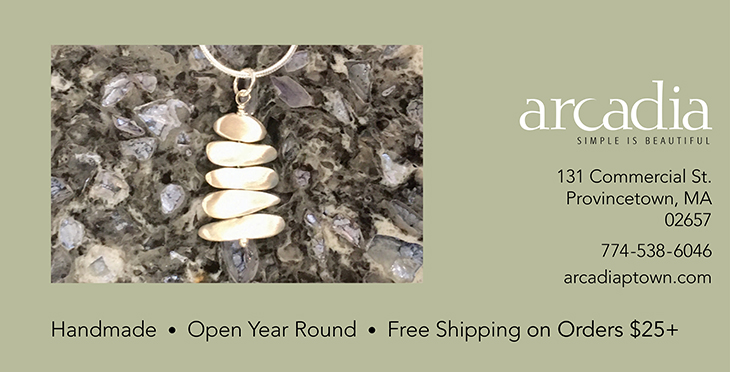On the rear wall of the nave at the Church of St. Mary of the Harbor in Provincetown is a triangular mural, Epiphany, painted by Robert Douglas Hunter. Religious iconography at the triptych’s center represents the Holy Trinity, but at the sides are less ecclesiastical figures: on the left, a group of fishermen, and on the right, a group of artists. A member of each group gestures toward a stylized star hovering above the dunes in a Provincetown sky streaked with the colors of evening.
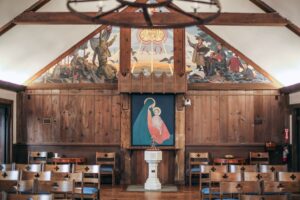
In Epiphany, the sacred and the everyday, the universal and the local converge. Some artists and fishermen look downward, others upward. Their positions capture the duality of an existence concerned with the here and now and something transcendent. The church’s other artwork feels similar — like many collections in town, it reflects Provincetown’s history as an art colony, but it’s inflected with mystical and theological Christian themes. St. Mary’s collection shows a side of Provincetown’s art colony rarely glimpsed.
In Hunter’s mural, he paints himself with his back to the viewer (perhaps a gesture of humility). With him are Frederick Waugh, Peter Hunt, Arnold Geissbuhler, and Richard Miller — all artists who were members of the congregation and whose works are still visible in the church. “The church was founded by artists, and we’re surrounded by their art all the time,” says Julia Perry, the church’s office manager and chair of Provincetown’s historical commission.

St. Mary, in the East End, traces its roots to 1919, when a group of Episcopalians purchased an old salt house. Later, they bought the Sandbar Club and floated it across the harbor from the West End. The two buildings were joined, one forming the nave, the other the sanctuary.
In 1933, the church installed its first vicar, the Rev. Robert Wood Nicholson, who is memorialized in a 1936 painting by Jerry Farnsworth. The image of the young vicar with a hawk over his shoulder reflects the influence of Farnsworth’s teacher, Charles Hawthorne, in its moody atmosphere and the figure’s well-modeled face set against a dark background.
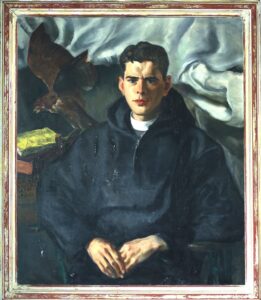
Like Farnsworth, who was born in Georgia, many of the artists who worshiped at St. Mary and made art for the congregation were drawn to Provincetown because of its creative community. Painter Frederick Waugh arrived in Provincetown later in life — he collaborated extensively with Nicholson on the church’s gardens, as noted in a document about the church’s art collection prepared by Provincetown artist Erna Partoll. Waugh also painted the striking Madonna and Child that hangs in a central place under Hunter’s mural. Its clean lines and flat shapes recall art deco and the symbolist painting of Waugh’s era, while Mary’s blue robe and the navy background echo the colors of the sea.
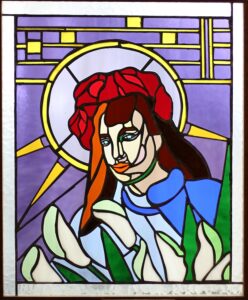
The ocean’s presence is always felt in this seaside church — a sanctus bell in the shape of a scallop shell rings with the same pitch as Provincetown’s fog-warning bell. One stained-glass window replaces the typical iconography of a dove with a seagull. The window, designed by Claude Jensen in 1961, is a circular composition: the gull flies down at an angle and a wave crashes up to meet it. Other stained-glass windows reveal the art-rich history and character of the church — there’s Hunter’s Madonna With Palette and a more recent piece, St. Cecilia, designed by Joan Pereira in 2006. Pereira, who died in 2021, sang in the church’s choir and chose to depict the patron saint of music in a decidedly modern image with bright colors and sharp geometry.

A few paintings by Pereira are also in the collection that lines the hallways and reception room adjacent to the sanctuary and nave. These works were donated to the church and aren’t as devotional as the ones in the areas of worship. It’s an eclectic mix, some from Provincetown’s most respected artists, including Mary Hackett, John Whorf, and George Yater. A few of them show the church, like Mary Hackett’s painting of the sanctuary and a stormy painting by Sol Wilson of the church viewed from the sea when it still had a steeple. (A hurricane would later claim it.)
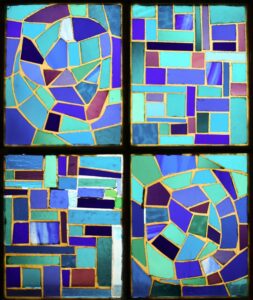
In the sanctuary, Arnold Geissbuhler, who lived in Provincetown in the 1930s, is represented by a sculpture of Christ atop a beam at the center of the church, flanked by two angels. Nearly all white except for subtle touches of color along the edges, the sculptures reflect Geissbuhler’s interest in both realism and abstraction. Their blocky shapes recall the simplicity of wooden medieval sculpture and abstracted modernist sculpture — art forms Geissbuhler would have been well acquainted with as a native of Switzerland who studied in Paris in the early 20th century.
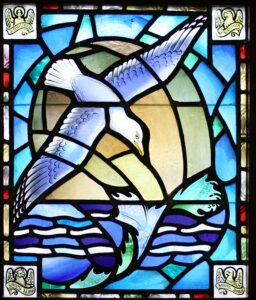
Geissbuhler came to the Cape after meeting a fellow art student in Paris, Elisabeth Chase from Dennis. The two married, and their daughters served as models for the angels in Geissbuhler’s sculptures. One daughter, Mirande, married Harry Holl, a founder of the Cape Museum of Art, which holds a lot of work by Geissbuhler. St. Mary also has a small-scale sculpture by Geissbuhler of St. Francis of Assisi, a favorite subject of artists.

The stylistic differences of the artists are apparent as one moves around the church. While Geissbuhler was influenced by European sculpture, Peter Hunt found his inspiration in folk art. He’s best known for his decorative paintings on furniture, but at St. Mary he’s represented by a large canvas in the church’s entrance: an exuberant Christmas scene with Mary and baby Jesus surrounded by symmetrical patterns of angels, Christmas trees, and garlands. It was found a decade ago rolled up in a storage space and shows Hunt’s joyful, unfussy manner. Gallerist Berta Walker had the piece restored and framed as a gift in memory of her parents, who were affiliated with the church and friends of Hunt.

The Easter narrative is represented prominently here with a fresco painted on a wall behind the altar. The fresco, titled The Triumphant Entry, depicts what Christians celebrate as Palm Sunday — in it, Jesus enters Jerusalem riding a donkey. He’s greeted by worshipers laying down their coats and waving palm branches. The piece was painted in 1928 by impressionist Richard Miller, who moved to Provincetown in 1917 and was known for his lush paintings of richly dressed women lounging outdoors. This work, painted into the wall with lime plaster and pigments, doesn’t reflect that style. Instead, Miller referenced a fresco in Padua,
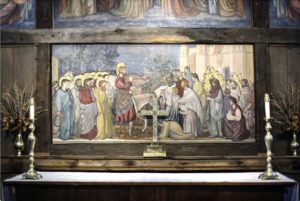
Italy by Giotto, who was born in 1266. Miller takes his composition and poses from Giotto but expands the image to include additional figures and flourishes like gold-leaf palm fronds.
Miller’s fresco is directly across from Hunter’s Epiphany, in which he painted himself reaching out to Miller. Hunter painted his mural in 1956, 13 years after Miller died and 28 years after Miller painted The Triumphant Entry. The physical gesture connects the two artists and represents the lineage of artists and artwork at St. Mary.

“This is a community of artists,” says the Rev. Brian Raiche, the church’s rector. “The art reflects the community and is part of the transcendent feel of the church. It lifts you up.”
